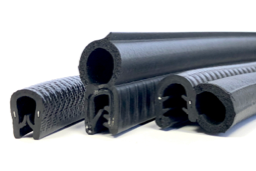Rubber Extrusions
We offer an extensive range of rubber extrusions, available in a comprehensive selection of shapes and sizes, suitable for almost every application. Our sections can be used as hatch seals, door seals, window seals and edge protection within any industry sector. We manufacture our extrusions using high quality materials including neoprene, nitrile, TPE, EPDM and silicone allowing you to choose a profile that is resistant to the elements and temperatures that it will come into contact with.
Our profiles are available in a range of different shapes and sizes depending on the required application. We stock one of the largest selections of cord, P, tadpole, U, T and D profiles allowing you to choose an extrusion suitable for the exact needs of your project.
If you cannot find a product suitable for your application, please contact us to discuss custom rubber extrusion options.
Frequently Asked Questions
What is a rubber extrusion?
A rubber extrusion is a solid rubber product often used for sealing, cushioning and edge production applications. It is the process of turning rubber compounds into a specific shape that has the same cross-sectional profile along its entire length. These profiles can vary in complexity, from simple shapes such as P sections to more intricate designs.
What is the rubber extrusion process?
The rubber extrusion manufacturing process creates linear lengths of rubber sections that have the same cross-sectional profile. The first step in manufacturing a section is to choose a rubber compound that allows for any temperature demands or substances that the profile may come into contact with. This compound is then fed into an extrusion machine where it is heated to become pliable. The extrusion process involves pushing this heated rubber compound through a tool, also known as a die, that extrudes the rubber to the desired shape and size.
Once extruded, the rubber is often cured and hardened. This step involves heating the rubber to initiate a chemical reaction that makes it more durable and resistant.
What materials can be used to manufacture rubber extrusions?
The rubber material used to manufacture a rubber extrusion should be carefully chosen based on the intended application. Each material has a unique set of properties, like resistance to heat, chemicals or weathering, dictating its suitability for different projects.
Almost any synthetic rubber compound can be used to manufacture rubber extrusions. Neoprene, EPDM, Silicone and PVC are commonly used due to their mass availability, low cost and desirable properties. However, it is also possible to manufacture sections from SBR, nitrile, TPR and Viton where the sealing solution requires a particular characteristic.
What is the difference between extruded and molded rubber?
Although extruded rubber sections and molded rubber products often serve the same sealing purpose, they differ in the way they are manufactured and the type of products they can create.
Extruded rubber is created by forcing the rubber compound through a die that produces long continuous lengths that have the same cross-sectional profile. Molded rubber involves placing a rubber compound into a mold cavity where it is then heated and pressurised. This causes the rubber to conform to the shape of the mold, allowing for the creation of three-dimensional products.
Rubber extrusions are usually used for applications where you need a long linear length of the same profile, such as round cords, P sections and U channels. This compares to molded rubber products such as gaskets and various custom-shaped components. Extrusions are best suited for continuous lengths, while moldings are ideal for three-dimensional items.








